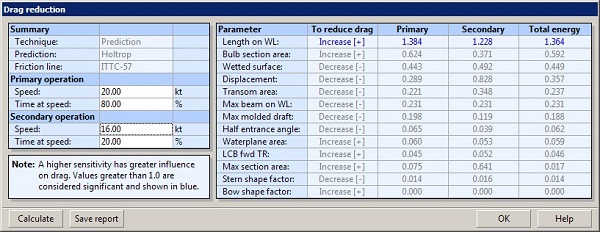Drag Reduction Analysis with HydroComp NavCad
HydroComp NavCad® is powerful software for predicting vessel resistance and propulsion. With growing emphasis on fuel consumption and efficiency, naval architects and marine engineers are continually looking to reduce drag using optimized hull forms. NavCad’s Drag Reduction tool provides insightful quantitative metrics for evaluating how a change in hull parameters can be implemented to reduce drag and increase performance and efficiency.
The Drag Reduction analysis can be applied to any NavCad project. Once the initial hull parameters have been entered, the predicted resistance can calculated using one of NavCad’s 36 resistance methods. This resistance curve is known as the “basis” resistance. The Drag Reduction analysis will investigate the influence of a small change in a given hull parameter (e.g. length, beam, displacement) on the resistance basis. The hull parameters are then organized by influence, with the most significant parameters to reduce drag presented at the top of the table. (See figure.)
Because many parameters are speed dependent, a beneficial change at a higher speed may actually be detrimental at lower speeds (e.g. transom area for planning vessels). In order to analyze drag reduction at lower cruise speeds and higher top speeds, NavCad’s drag reduction analysis allows the user to enter primary and secondary operating profiles using speed and time at speed.


that matters most
Get the latest maritime news delivered to your inbox daily.
Additionally, since the motivation for drag reduction is typically fuel consumption, the magnitude of the drag at speed should be considered, not solely the percent reduction in drag. In other words, since resistance at top speed can be substantially more than lower speeds, it should have greater significance in the analysis.NavCad’s Drag Reduction analysis includes a “total energy” weighted influence, which is calculated based on the primary and secondaryoperating profiles. This “total energy” approach allows the user to truly evaluate the effect of a hull parameter on the overall energy consumption of the vessel.
NavCad’s Drag Reduction tool offers practical insight into the “What if” questions: What if half angle of entrance is decreased? What if I add a bulb? What if the LCG is shifted aft? The Drag Reduction tool allows designers and naval architects to rapidly evaluate the influence of hull parameters on vessel drag and, more importantly, on real operational efficiency.
The products and services herein described in this press release are not endorsed by The Maritime Executive.
